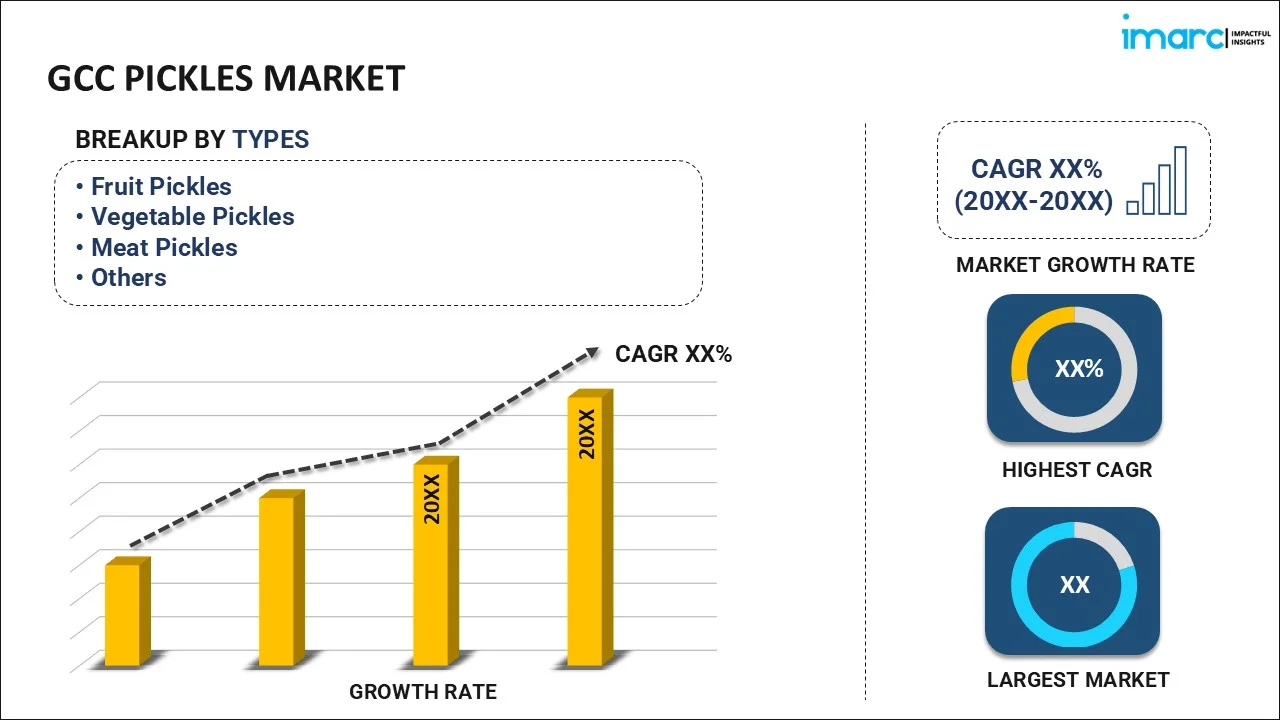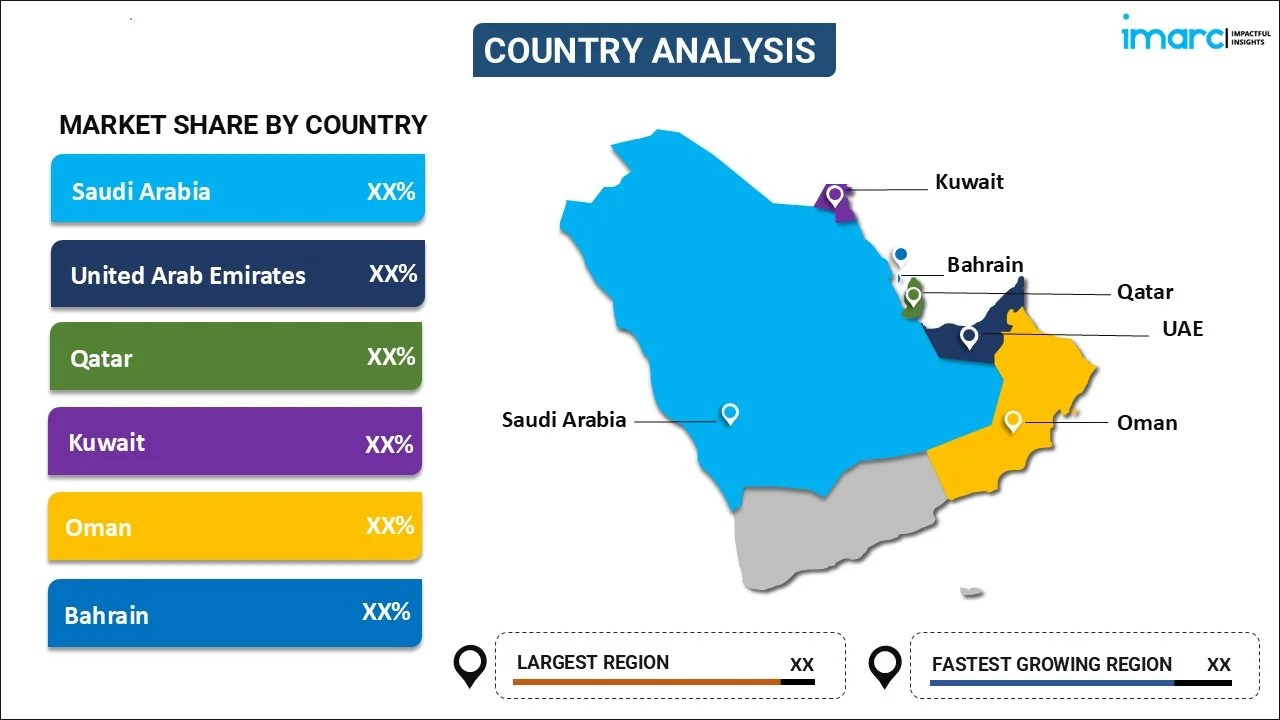
GCC Pickles Market Report by Type (Fruit Pickles, Vegetable Pickles, Meat Pickles, and Others), Taste (Sweet Pickles, Salty Pickles, Sour Pickles), Distribution Channel (Supermarkets and Hypermarkets, Convenience Stores, Independent Retailers, Online Stores, and Others), and Country 2025-2033
Market Overview:
The GCC pickles market size reached USD 202.5 Million in 2024. Looking forward, IMARC Group expects the market to reach USD 290.7 Million by 2033, exhibiting a growth rate (CAGR) of 3.7% during 2025-2033. The rising consumer preference for diverse flavors in the GCC region, increasing awareness of the health benefits of fermented and probiotic-rich foods, and rapid expansion of the foodservice sector represent some of the key factors driving the market.
|
Report Attribute
|
Key Statistics
|
|---|---|
|
Base Year
|
2024 |
|
Forecast Years
|
2025-2033
|
|
Historical Years
|
2019-2024
|
| Market Size in 2024 | USD 202.5 Million |
| Market Forecast in 2033 | USD 290.7 Million |
| Market Growth Rate (2025-2033) | 3.7% |
Pickles are a type of preserved food product made from fruits or vegetables that have undergone a process of fermentation or brining, often combined with spices and seasonings. This preservation method extends the shelf life of the food and imparts unique flavors and textures that make pickles a popular and versatile condiment in various cuisines. The process of making pickles typically involves immersing the chosen fruits or vegetables in a solution of salt and water, known as brine. This brining process helps to draw out moisture from the produce while creating an environment conducive to the growth of beneficial microorganisms, such as lactic acid bacteria, which initiate the fermentation process. The fermentation imparts a tangy flavor and contributes to the development of probiotics, promoting gut health. In addition to the fermentation method, pickles can be made through a process called canning, where the produce is preserved in vinegar or a vinegar-based solution. This method preserves the food and adds a distinct acidic flavor to the final product. Pickles come in a wide variety of flavors, colors, and textures, ranging from sour to sweet and spicy. They are widely enjoyed as a side dish, garnish, or condiment that complements a range of meals, from sandwiches to salads and rice dishes. At present, pickles are gaining immense traction across the GCC countries due to their ability to add contrasting tastes and textures and their potential health benefits.
GCC Pickles Market Trends/Drivers:
The growing demand for pickles integral to traditional meals and cuisines owing to the region's rich culinary diversity and cultural preferences represents the primary factor driving the market growth. Moreover, the increasing health consciousness among consumers is propelling market growth, as pickles made through fermentation offer probiotic benefits that promote gut health. This aligns with the growing interest in functional foods that provide flavor and well-being. Additionally, the expanding food service industry across the GCC countries is positively influencing the market growth, as pickles find extensive use in enhancing the taste profiles of various dishes served in restaurants and catering establishments. Besides this, the rising demand for pickles by chefs aiming to cater to diverse palates due to their convenience and versatility is another major growth-inducing factor. Along with this, the increasing consumption of convenient and flavorful food options owing to inflating consumer disposable incomes and changing lifestyles in the GCC region has catalyzed market growth. Furthermore, numerous product innovations, such as the introduction of unique flavor profiles and exploring innovative packaging solutions, are contributing to the market growth. Apart from this, heightened awareness of the health benefits of fermented and probiotic-rich foods has augmented the demand for pickles. Other factors, including the emerging trend of blending traditional recipes with contemporary flavors and international cuisines, increasing shift toward snacking habits, and growing influx of tourists in various GCC countries and their interest in exploring local cuisines, are also anticipated to drive the market further.
GCC Pickles Industry Segmentation:
IMARC Group provides an analysis of the key trends in each segment of the GCC pickles market report, along with forecasts at the regional and country levels for 2025-2033. Our report has categorized the market based on type, taste, and distribution channel.
Breakup by Type:

- Fruit Pickles
- Vegetable Pickles
- Meat Pickles
- Others
The report has provided a detailed breakup and analysis of the market based on the type. This includes fruit pickles, vegetable pickles, meat pickles, and others.
Breakup by Taste:
- Sweet Pickles
- Salty Pickles
- Sour Pickles
A detailed breakup and analysis of the market based on the taste has also been provided in the report. This includes sweet, salty and sour pickles.
Breakup by Distribution Channel:
- Supermarkets and Hypermarkets
- Convenience Stores
- Independent Retailers
- Online Stores
- Others
A detailed breakup and analysis of the market based on the distribution channel has also been provided in the report. This includes supermarkets and hypermarkets, convenience stores, independent retailers, online stores, and others.
Breakup by Country:

- Saudi Arabia
- UAE
- Qatar
- Bahrain
- Kuwait
- Oman
The report has also provided a comprehensive analysis of all the major regional markets, which include Saudi Arabia, the UAE, Qatar, Bahrain, Kuwait, and Oman.
Competitive Landscape:
The report has also provided a comprehensive analysis of the competitive landscape in the market. Competitive analysis such as market structure, key player positioning, top winning strategies, competitive dashboard, and company evaluation quadrant has been covered in the report. Also, detailed profiles of all major companies have been provided.
GCC Pickles Market Report Scope:
| Report Features | Details |
|---|---|
| Base Year of the Analysis | 2024 |
| Historical Period | 2019-2024 |
| Forecast Period | 2025-2033 |
| Units | Million USD |
| Scope of the Report | Exploration of Historical and Forecast Trends, Industry Catalysts and Challenges, Segment-Wise Historical and Predictive Market Assessment:
|
| Types Covered | Fruit Pickles, Vegetable Pickles, Meat Pickles, Others |
| Tastes Covered | Sweet Pickles, Salty Pickles, Sour Pickles |
| Distribution Channels Covered | Supermarkets and Hypermarkets, Convenience Stores, Independent Retailers, Online Stores, Others |
| Countries Covered | Saudi Arabia, UAE, Qatar, Bahrain, Kuwait, Oman |
| Customization Scope | 10% Free Customization |
| Post-Sale Analyst Support | 10-12 Weeks |
| Delivery Format | PDF and Excel through Email (We can also provide the editable version of the report in PPT/Word format on special request) |
Key Questions Answered in This Report:
- How has the GCC pickles market performed so far and how will it perform in the coming years?
- What has been the impact of COVID-19 on the GCC pickles market?
- What is the breakup of the GCC pickles market on the basis of type?
- What is the breakup of the GCC pickles market on the basis of taste?
- What is the breakup of the GCC pickles market on the basis of distribution channel?
- What are the various stages in the value chain of the GCC pickles market?
- What are the key driving factors and challenges in the GCC pickles market?
- What is the structure of the GCC pickles market and who are the key players?
- What is the degree of competition in the GCC pickles market?
Key Benefits for Stakeholders:
- IMARC’s report offers a comprehensive quantitative analysis of various market segments, historical and current market trends, market forecasts, and dynamics of the GCC pickles market from 2019-2033.
- The research study provides the latest information on the market drivers, challenges, and opportunities in the GCC pickles market.
- Porter's five forces analysis assist stakeholders in assessing the impact of new entrants, competitive rivalry, supplier power, buyer power, and the threat of substitution. It helps stakeholders to analyze the level of competition within the GCC pickles industry and its attractiveness.
- Competitive landscape allows stakeholders to understand their competitive environment and provides an insight into the current positions of key players in the market.
Need more help?
- Speak to our experienced analysts for insights on the current market scenarios.
- Include additional segments and countries to customize the report as per your requirement.
- Gain an unparalleled competitive advantage in your domain by understanding how to utilize the report and positively impacting your operations and revenue.
- For further assistance, please connect with our analysts.
 Inquire Before Buying
Inquire Before Buying
 Speak to an Analyst
Speak to an Analyst
 Request Brochure
Request Brochure
 Request Customization
Request Customization




.webp)




.webp)












